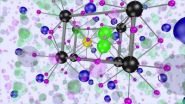(Press-News.org) A team of observational cosmologists may have found evidence that cosmic inflation occurred a fraction of a second after the Big Bang, a point predicted 18 years ago by Johns Hopkins University cosmologist and theoretical physicist Marc Kamionkowski.
At a news conference earlier today at the Harvard-Smithsonian Center for Astrophysics in Cambridge, Mass, researchers from the BICEP2 collaboration, a partnership between Harvard University and the California Institute of Technology, announced the first direct evidence for this sudden and vast expansion of the newborn universe. Their data also represents the first images of gravitational waves, or ripples in space-time. These waves have been described as the "first tremors of the Big Bang."
The results came from observations by the BICEP2 telescope at the South Pole of the cosmic microwave background – a faint glow left over from the Big Bang. Tiny fluctuations in this afterglow provide clues to conditions in the early universe. This marker is part of a long-sought signature of events that occurred a breath after the Big Bang and has major implications for our understanding of the first moments of the beginning of the universe more than 14 billion years ago.
"It's not every day that you wake up and learn something new about what happened one trillionth of a trillionth of a trillionth of a second after the Big Bang," Kamionkowski said.
In 1996, Kamionkowski, then an assistant professor at Columbia University, and his collaborators theorized that the polarization pattern in the cosmic microwave background, or CMB, could be tracked geometrically. Since the cosmic microwave background is a form of light, it exhibits all the properties of light, including polarization. On Earth, sunlight is scattered by the atmosphere and becomes polarized, which is why polarized sunglasses help reduce glare. In space, the cosmic microwave background was scattered by atoms and electrons and became polarized too.
The team suspected that one unit, called B-modes, would appear reversed in a mirror image in a swirly pattern when observed through the CMB. BICEP2's announcement is the first step in supporting that claim.
The magnitude of these B-modes sheds light on the new physics responsible for inflation, or the immediate expansion of the universe at its beginning, and in essence created a new field of study in cosmology.
Kamionkowski, a professor in Johns Hopkins' Department of Physics and Astronomy since 2011, is considered one of the world's leading theoretical physicists for his work in large-scale structures and the early history of the universe. He has spent much of his career researching astrophysics, cosmology and elementary particle theory. He said news of this discovery is exciting but "I'm trying to maintain a sober caution, because extraordinary results really do require extraordinary scrutiny, and the results that were announced have yet to be vetted by the outside community."
Several predictions of cosmic inflation have been verified by a number of measurements over time, but primarily by NASA's Wilkinson Microwave Anisotropy Probe, or WMAP, led by Johns Hopkins University astrophysicist Charles L. Bennett. He, along with cosmologist and assistant professor Tobias Marriage, currently co-lead the Cosmology Large-Angular Scale Surveyor (CLASS) project which will do similar work as the BICEP2 collaboration. CLASS is an instrument that will be located in Chile and is designed to test the inflation theory's account of the first moments of the universe.
Institutions like Johns Hopkins as well as others in the astronomical community will continue to test and verify the BICEP2 findings. Meanwhile, Kamionkowski, who is not a member of the BICEP2 experiments team, was recognized as one of the theorists and participated in a host of events applauding the released results.
INFORMATION:
THE JOHNS HOPKINS UNIVERSITY
OFFICE OF COMMUNICATIONS
3910 Keswick Rd., Suite N-2600
Baltimore, MD 21211
MEDIA CONTACT: Latarsha Gatlin
Office: 443-997-9909
Cell: 443-608-6498
lgatlin1@jhu.edu
Cosmic inflation finding first predicted by JHU cosmologist
2014-03-18
ELSE PRESS RELEASES FROM THIS DATE:
UCLA geographers create 'easy button' to calculate river flows from space
2014-03-18
The frustrated attempts of a UCLA graduate student to quantify the amount of water draining from Greenland's melting ice sheet led him to devise a new way to measure river flows from outer space, he and his professor report in a new study.
The new approach relies exclusively on the measurements of a river's width over time, which can be obtained from freely available satellite imagery.
Currently, hydrologists calculate a river's discharge — the volume of water running through it at any given time — by taking a series of measurements on the ground, including not ...
Workplace flexibility still a myth for most
2014-03-18
CHESTNUT HILL, MA (March 17th): Workplace flexibility – it's a phrase that might be appealing to job seekers or make a company look good, but a new study by the Sloan Center on Aging and Work at Boston College shows flexible work options are out of reach for most employees and that when they are offered, arrangements are limited in size and scope.
"While large percentages of employers report that they have at least some workplace flexibility, the number of options is usually limited and they are typically not available to the entire workforce," says Marcie Pitt-Catsouphes, ...
Drug trafficking corrupts Kyrgyzstan's politics and underworld
2014-03-18
PRINCETON, N.J.—Kyrgyzstan, a landlocked and mountainous country in Central Asia, serves a powerful role in the Eurasian drug trade by playing the "mule" that carts heroin and other opiates between Afghanistan and Russia. Many researchers theorize that this lucrative industry has taken root in Kyrgyzstan – a country with few natural resources and industries – with significant support and leeway from its government, making it a "narco-state."
In the first examination of its kind, a researcher at Princeton University's Woodrow Wilson School writes in the International ...
Innovative computer under scrutiny
2014-03-18
D-Wave – a special computing machine with this name has been getting computer scientists and physicists talking for a number of years now. The Canadian technology company of the same name is advertising the machine as a quantum computer. However, whether or not the machine does in fact use quantum effects is the subject of controversial debate amongst experts in the field. If it does, then this would make D-Wave the world's first commercially available quantum computer.
The company sold its system to illustrious customers, piquing the interest of the scientific community ...
NASA satellite sees Tropical Cyclone Gillian return to remnant low status
2014-03-18
NASA's Aqua satellite captured a visible image of Tropical Cyclone Gillian's remnants in the southern Arafura Sea today, as it passes north of Australia's "Top End."
During the week of March 10, Tropical Cyclone Gillian formed in the northern Gulf of Carpentaria and made a brief landfall on the Western Cape York Peninsula, weakening to a remnant low. After re-emerging in the Gulf, Gillian became a tropical storm again and by March 17 had again weakened to a remnant low as it exited the Gulf and moved into the Arafura Sea.
The MODIS or Moderate Resolution Imaging Spectroradiometer ...
Will health care reform require new population health management strategies?
2014-03-18
New Rochelle, NY, March 17, 2014–In response to the 2010 Affordable Care Act, employers may no long offer traditional employee health care benefits as they protect themselves from rising health care costs and seek to minimize their risk. How the shifting landscape of health care coverage will impact population health management providers, employers, and employees is the focus of a commentary in Population Health Management, a peer-reviewed journal from Mary Ann Liebert, Inc., publishers. The article is available free on the Population Health Management website at http://www.liebertpub.com/pop.
Bruce ...
Climatologists offer explanation for widening of Earth's tropical belt
2014-03-18
RIVERSIDE, Calif. — Recent studies have shown that the Earth's tropical belt — demarcated, roughly, by the Tropics of Cancer and Capricorn — has progressively expanded since at least the late 1970s. Several explanations for this widening have been proposed, such as radiative forcing due to greenhouse gas increase and stratospheric ozone depletion.
Now, a team of climatologists, led by researchers at the University of California, Riverside, posits that the recent widening of the tropical belt is primarily caused by multi-decadal sea surface temperature variability in the ...
Strengthening learning in children: Get outside and play
2014-03-18
University of Cincinnati researchers are reporting on the educational and health benefits of specially created outdoor play environments for children. Victoria Carr, a UC associate professor of education and director of the UC Arlitt Child and Family Research and Education Center, and Eleanor Luken, a former UC research associate for the Arlitt Center and current doctoral student at City University of New York, take a look at this growing trend around the world in an article published this month in the International Journal of Play.
Typically called playscapes, these ...
Bright future for protein nanoprobes
2014-03-18
The term a "brighter future" might be a cliché, but in the case of ultra-small probes for lighting up individual proteins, it is now most appropriate. Researchers at the U.S. Department of Energy (DOE)'s Lawrence Berkeley National Laboratory (Berkeley Lab) have discovered surprising new rules for creating ultra-bright light-emitting crystals that are less than 10 nanometers in diameter. These ultra-tiny but ultra-bright nanoprobes should be a big asset for biological imaging, especially deep-tissue optical imaging of neurons in the brain.
Working at the Molecular Foundry, ...
First guidelines for patients with pulmonary hypertension in sickle cell disease
2014-03-18
(Boston) –Boston Medical Center (BMC) and Boston University School of Medicine (BUSM) physicians have helped create the first set of clinical guidelines for treating patients with pulmonary hypertension in sickle cell disease. Elizabeth Klings, MD, director of the pulmonary hypertension inpatient and education program at BMC and associate professor of medicine at BUSM, spearheaded the development of these guidelines, which are published in the American Journal of Respiratory and Critical Care Medicine.
Several studies conducted in the past decade have demonstrated that ...




